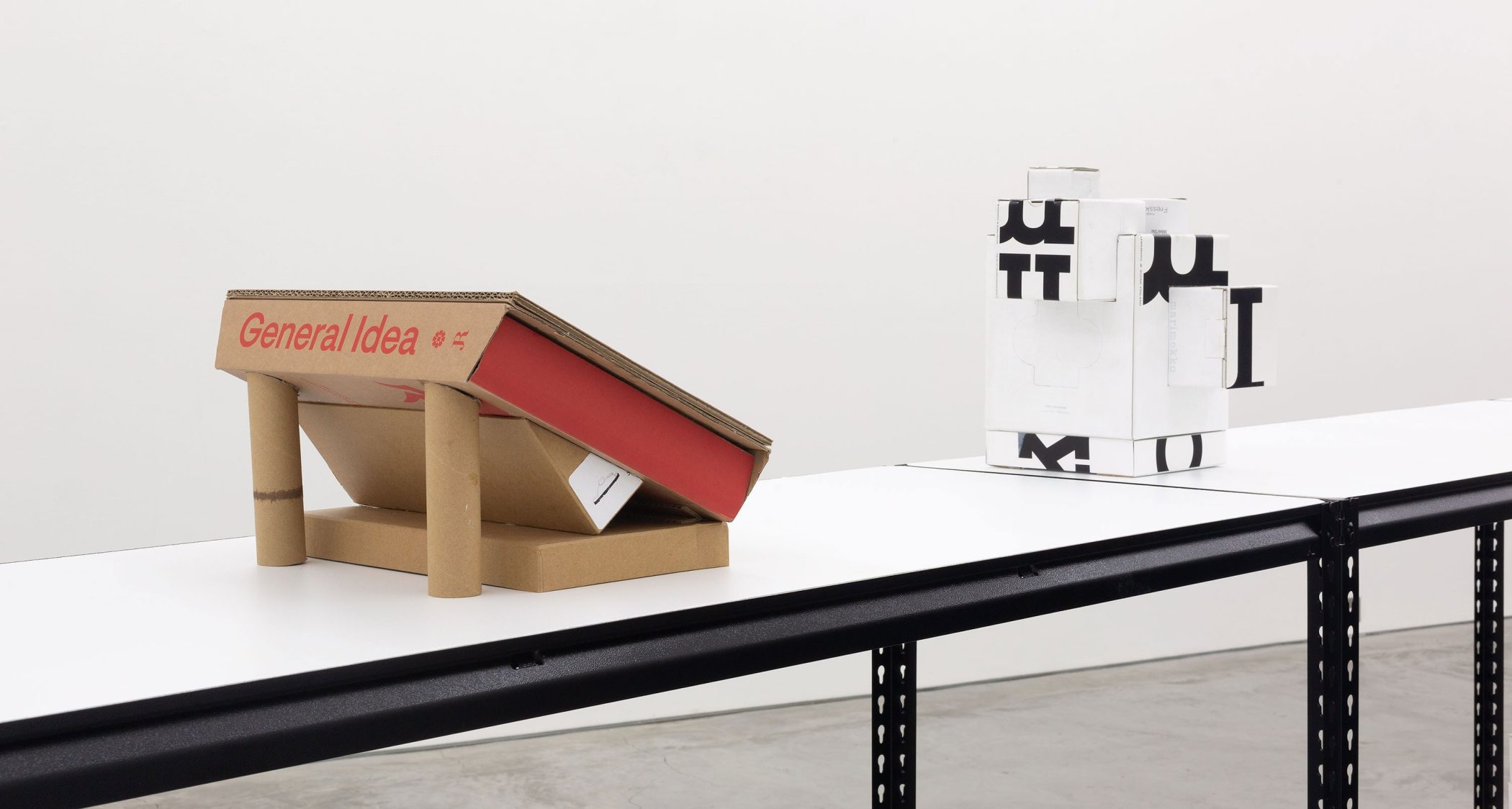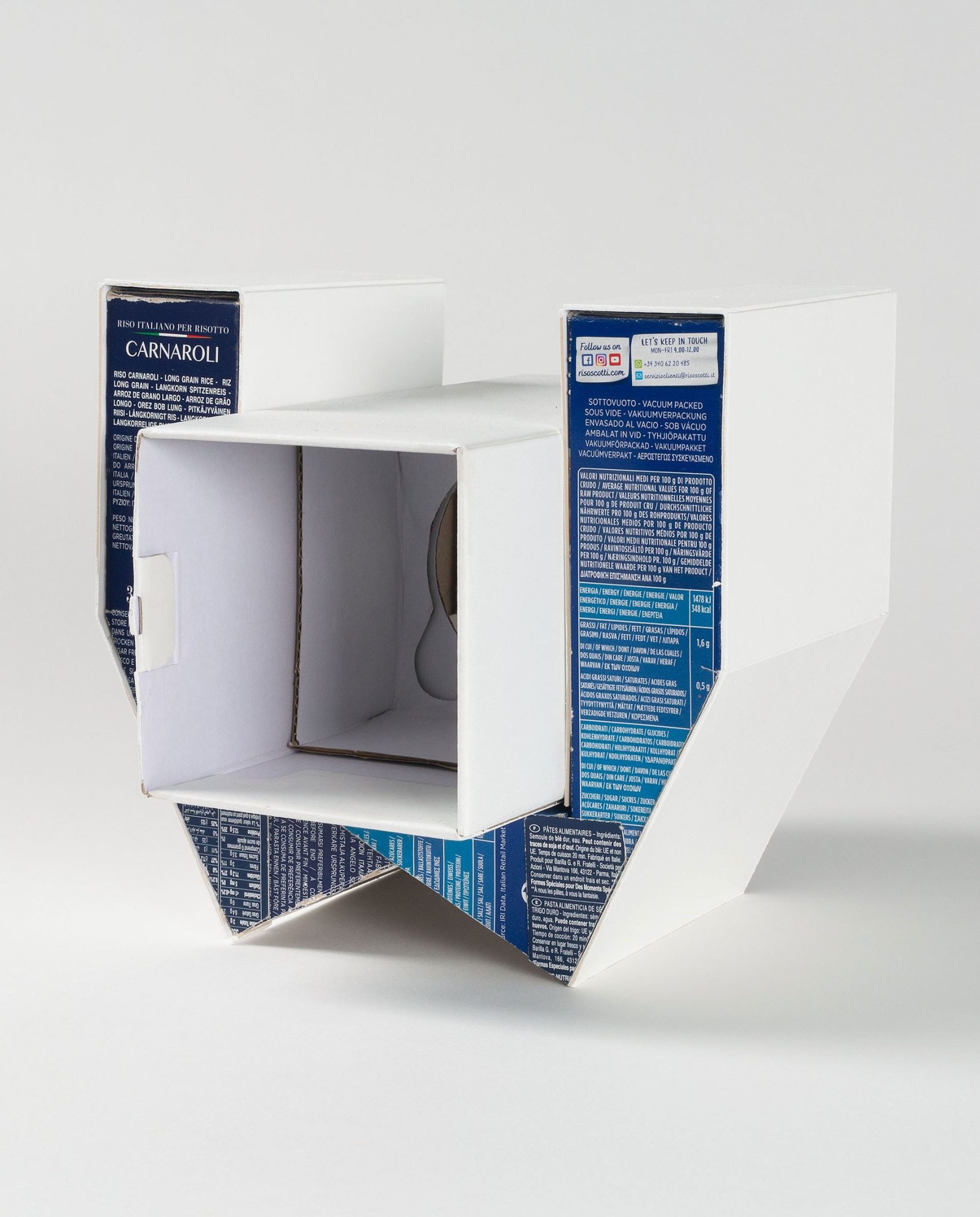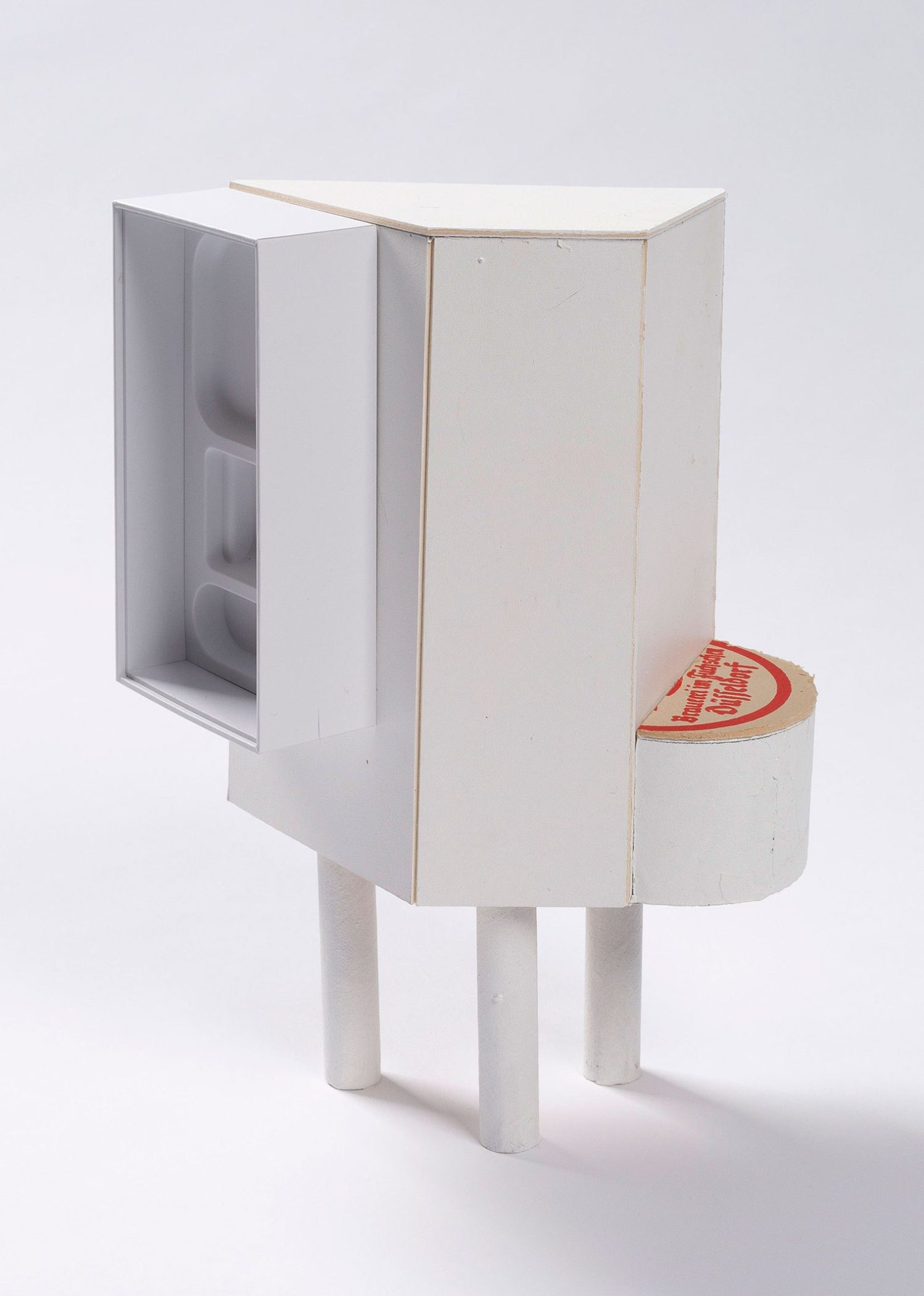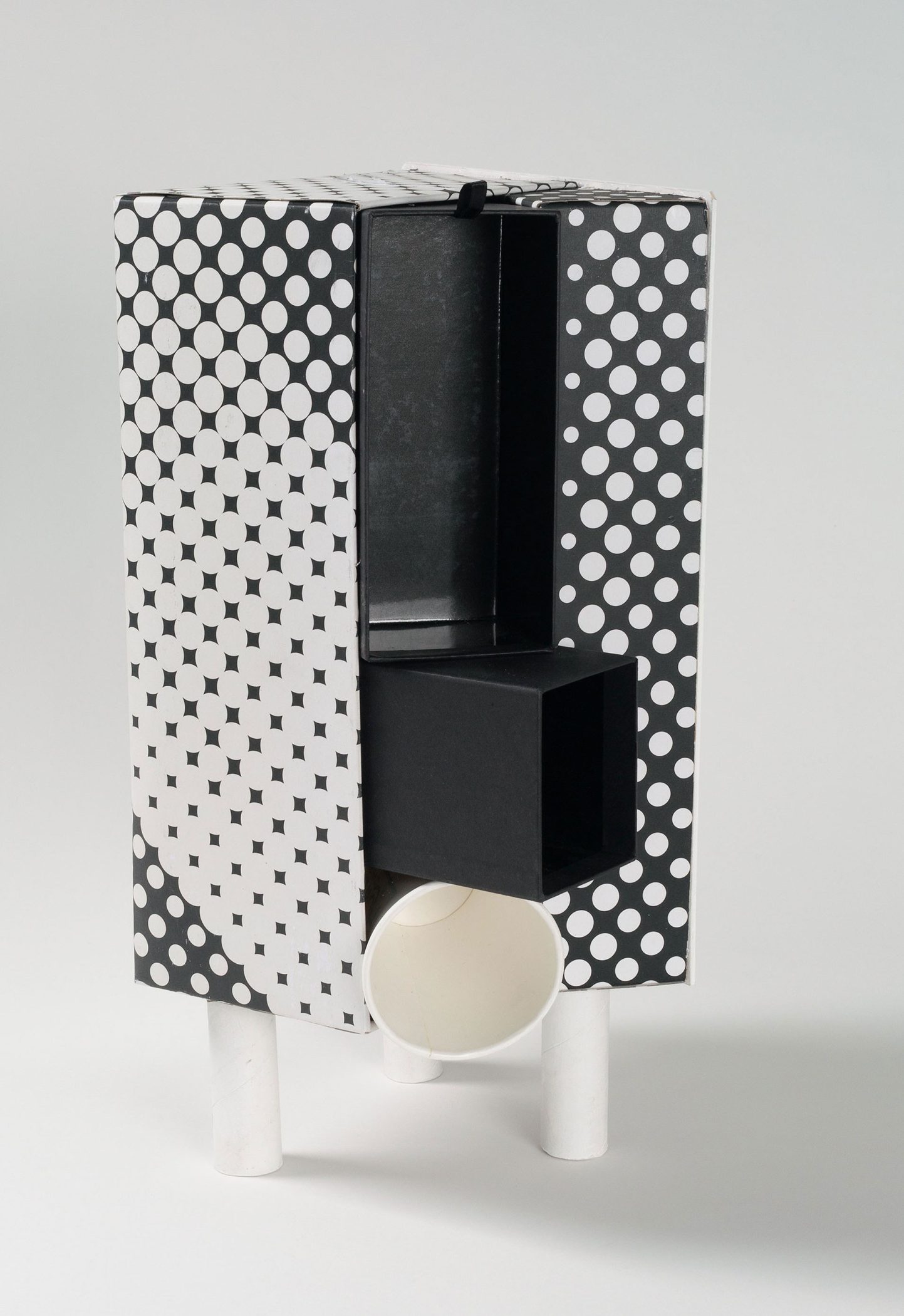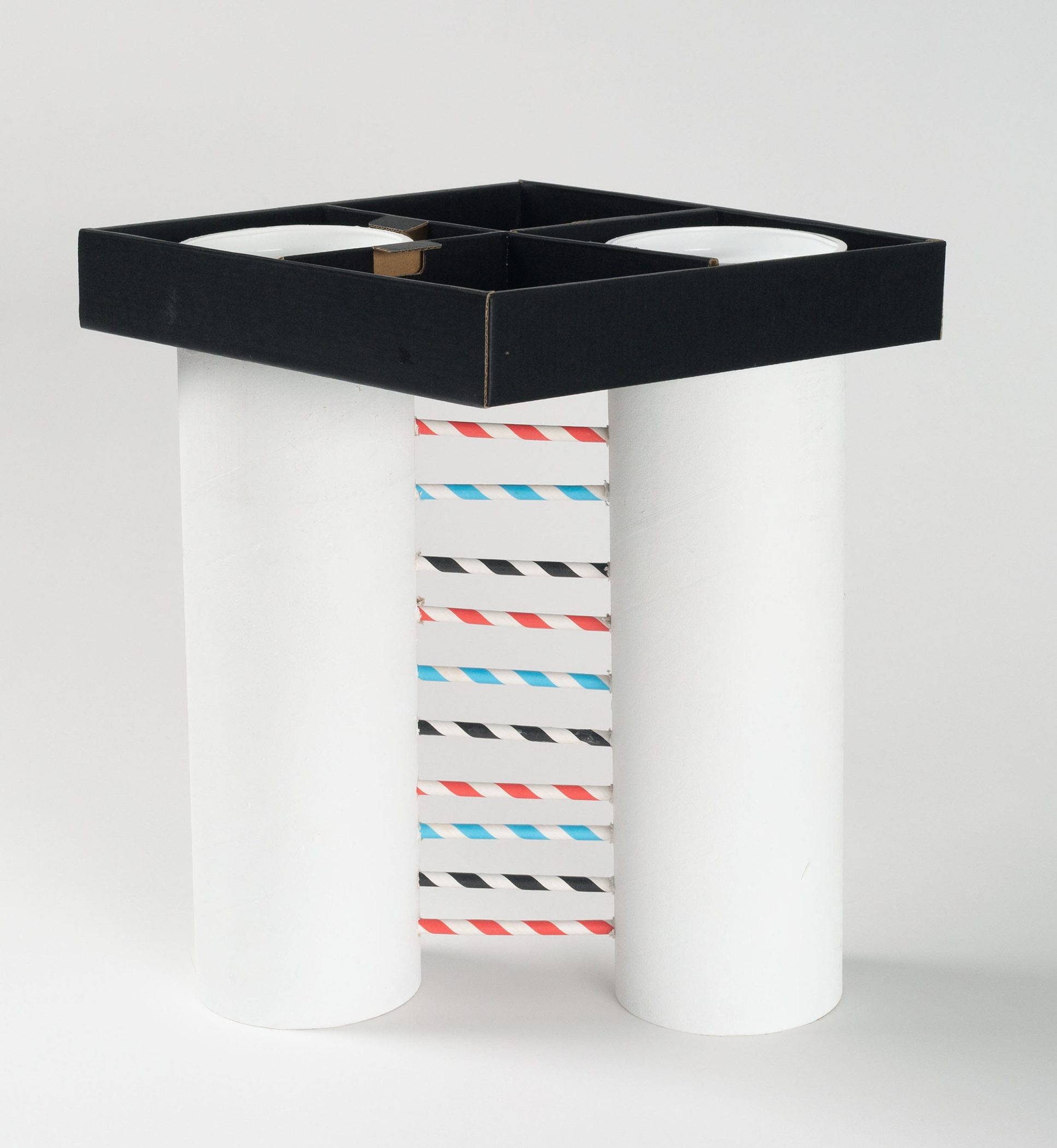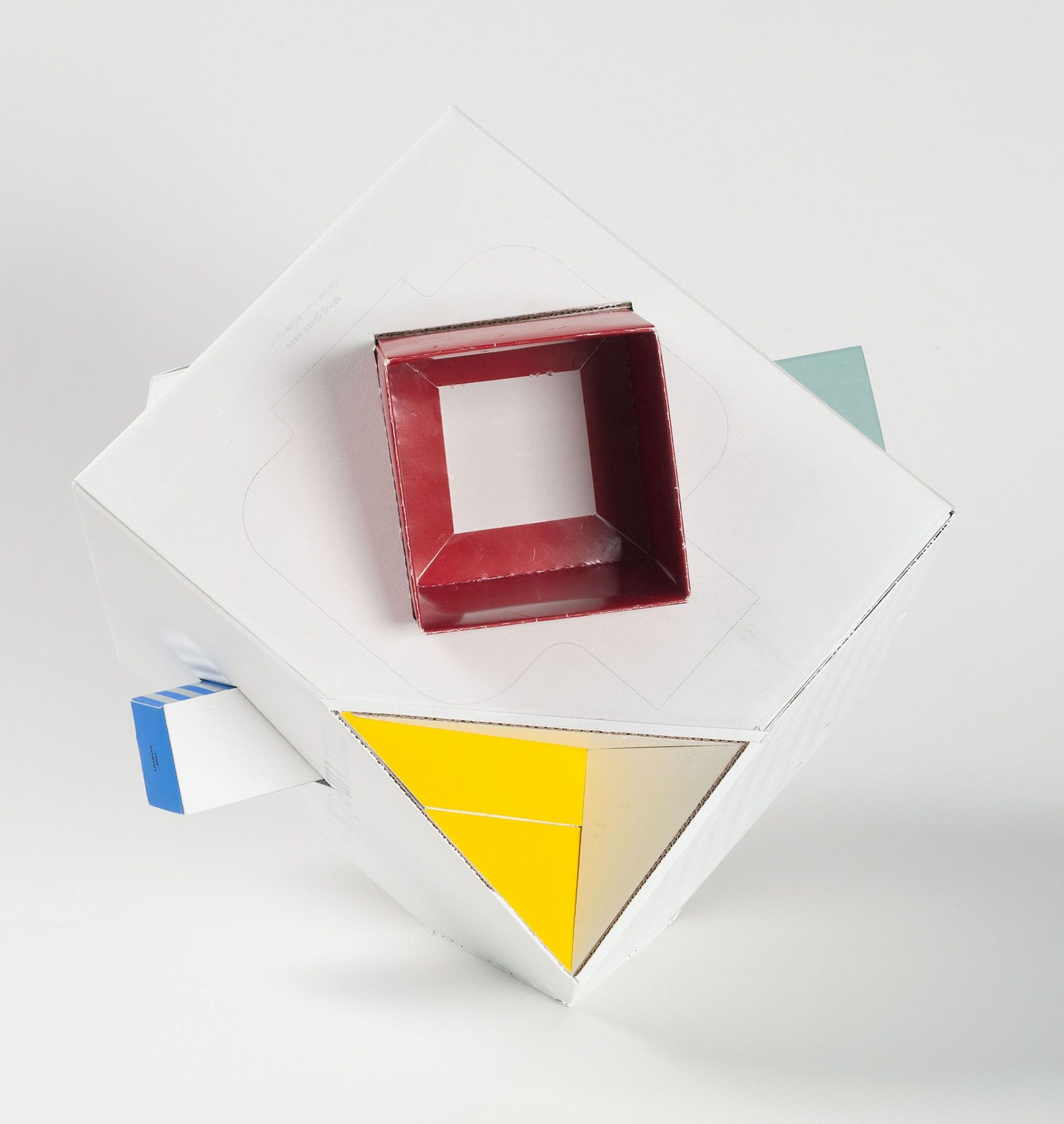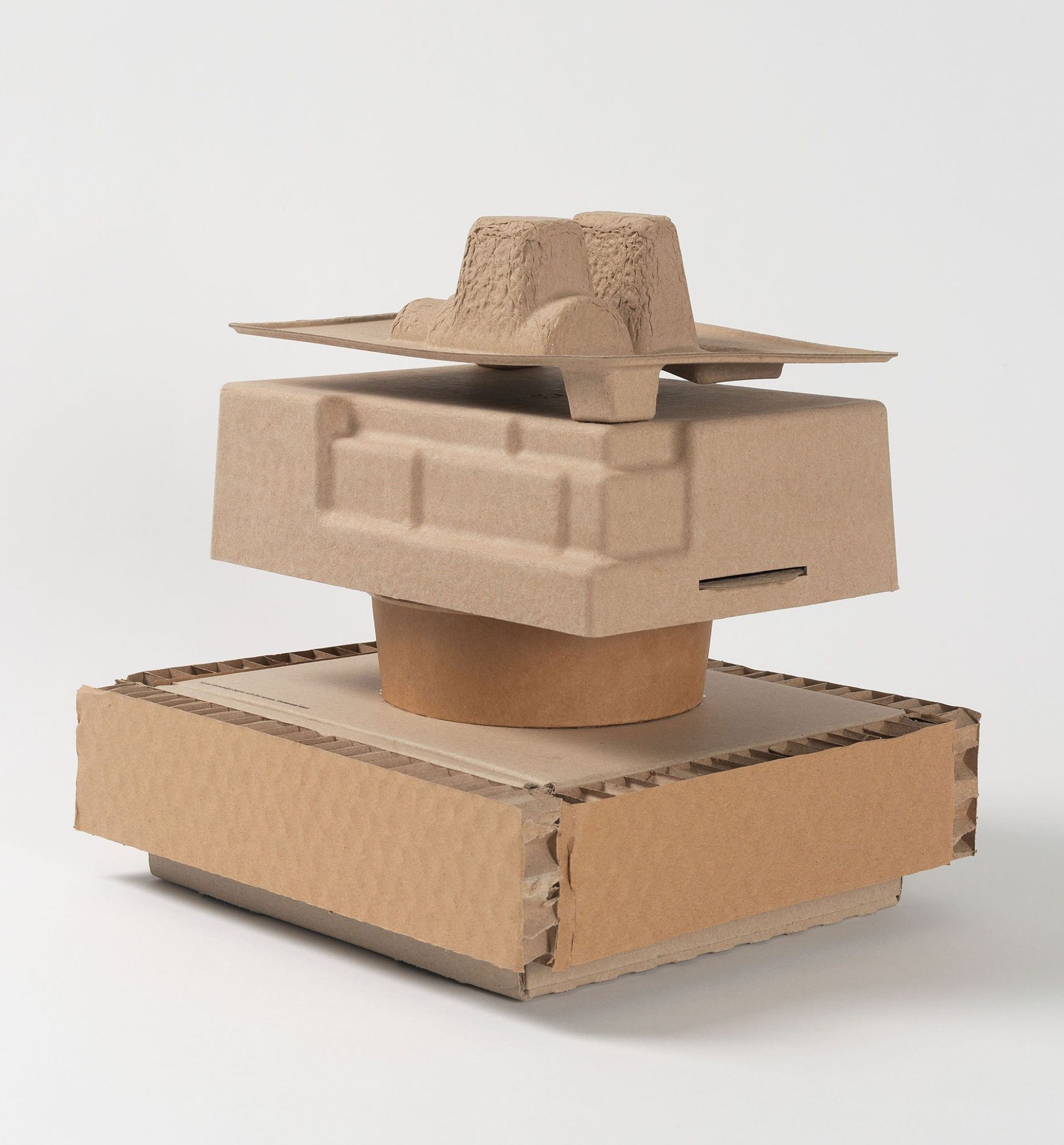Rose Nolan
Working Models
18th March – 15th April 2023
Anna Schwartz Gallery
Working Models
by Ingrid Periz
In the architectural design process working models are used to check the proportion, volume and shape of works whose final form is still being determined. At once representational and provisional, working models are also tools for they enable a further thinking through or refinement of a drawn-up structure. Rose Nolan’s working models borrow their namesakes’ sense of possibility but are fully independent entities whose titles come only after they are completed. No plan or drawing brings them forth, instead their starting point is the potential Nolan sees in found packaging, the too-readily discarded miracles of folded cardboard and moulded plastics along with the unconscious humour of any brand’s printed verbal address.
Nolan fuses a longstanding interest in architecture with a playful, hands-on inventiveness in these transformations. As boxes are stuck together and refashioned, striped waxed straws become covered walkways linking cardboard silos, a stack of tea packets grows into a tower, and a blister pack reveals itself as serried skylights. Nolan treats her found material here as ready-mades, just as she has long done with overheard phrases or found text in other areas of her practice like Word Work. Combining addition and excision, the Working Models nod to collage and assemblage but Nolan’s procedure is arguably her own. Their materials — familiar, often humble stuff otherwise destined for the bin– work against any sense of architectural authority, just as this domestic familiarity deflates any possible monumentality.
The earliest iterations of the Working Models were largely all white, acknowledging the canonical precept that linked the identity of modernist architecture to the whiteness of its surfaces, as architectural historian Mark Wigley has put it. Highlighted by careful use of black and the tiniest hints of colour, Nolan’s Working Models’ white was rarely Ripolin pure white, modernist architecture’s paint of choice. Variations in white cardboard, the stripes of revealed barcodes, shaded apertures, and painted, whited-out labels gave variety to an essentially monochromatic palette. Colour announces itself in the more recent Working Models. Adobe House rhymes cardboard’s woody brown with the look of dried mud, CHAPEL sings resplendent in red and pink, while other works are grounded on coloured bases. Many of these colours are new in Rose Nolan’s palette — the warm flesh of wooden cheese containers, cosmetic box coral, Adidas blue — and having been found, and retained, they become in the Working Models Rose Nolan’s own. Just as any building is a “portrait” of its designer, the Working Models, “portraits” of never-to-be-built buildings, are portraits too of Rose Nolan, artist and consumer.
Like colour, found text comes into its own too, occasionally in glorious silliness — FUN INFUSER; seriously, Durable; sustainable, simple, stylish. An interest in address — who’s saying what to whom — is a recurring feature of Nolan’s practice, as is the artist’s regular categorization of varieties of work. The earliest Working Models were shown as Homework in 2005; they can also be seen as little versions of her photographic series Big Still Lives, where modernist buildings were seen in scaled-up sculptural terms, and equally, given their occasional hints of label, warning and instruction, as tiny incarnations of Word Work.
Rose Nolan does not yet have an Art Work category but there’s no end of art in the Working Models. Shape-shifting Picasso lurks in CHAPEL, at once avian and reptilian and sporting a bumpy spine of women’s faces, while a number of Working Models give three-dimensional form to the expanded planarity of analytical Cubism. Fold marks retained on two-dimensional cardboard surfaces suggest the possibility of spatiality. House of the Year, a square box fractured through the addition of other boxes, framed apertures and cut vertices, is a little Cubist cube pleading “unbox me” on blue. In Signature Style the wrap-around text works like a printed pattern, a bit of papier collé which, at some angles, disturbs any sense of three-dimensionality. And New Age / Care Facility recycles one of synthetic Cubism’s principal motifs — the wine bottle — here a real half-bottle plastic sleeve — making a work that gives the look of typically flat late Cubism a three-dimensional form. Other Working Models quote art directly, incorporatingthe soft mauve minimalism of Robert Jacks, Stephen Bram’s fractured patterns and Alvar Aalto’s encircling greens — images of art works and paper collé, treated as elements of the real.
The boxes used here have held, among other things, laundry detergent, vegan doughnuts, hot coffee (and coffee cups), Chanel, Marimekko, Apple products, work boots, running shoes, and wine, both fancy French and cheap, a gamut of staples, consumer durables and luxuries. Rose Nolan tells me that sometimes she likes the box more than what’s in it, fully aware that packaging is as much ad as branding. Her transformations might well suspend that mysterious appeal Marx called commodity fetishism by subverting the boxes’ purpose and address; the appeal of the Working Models is however all their own.
Images
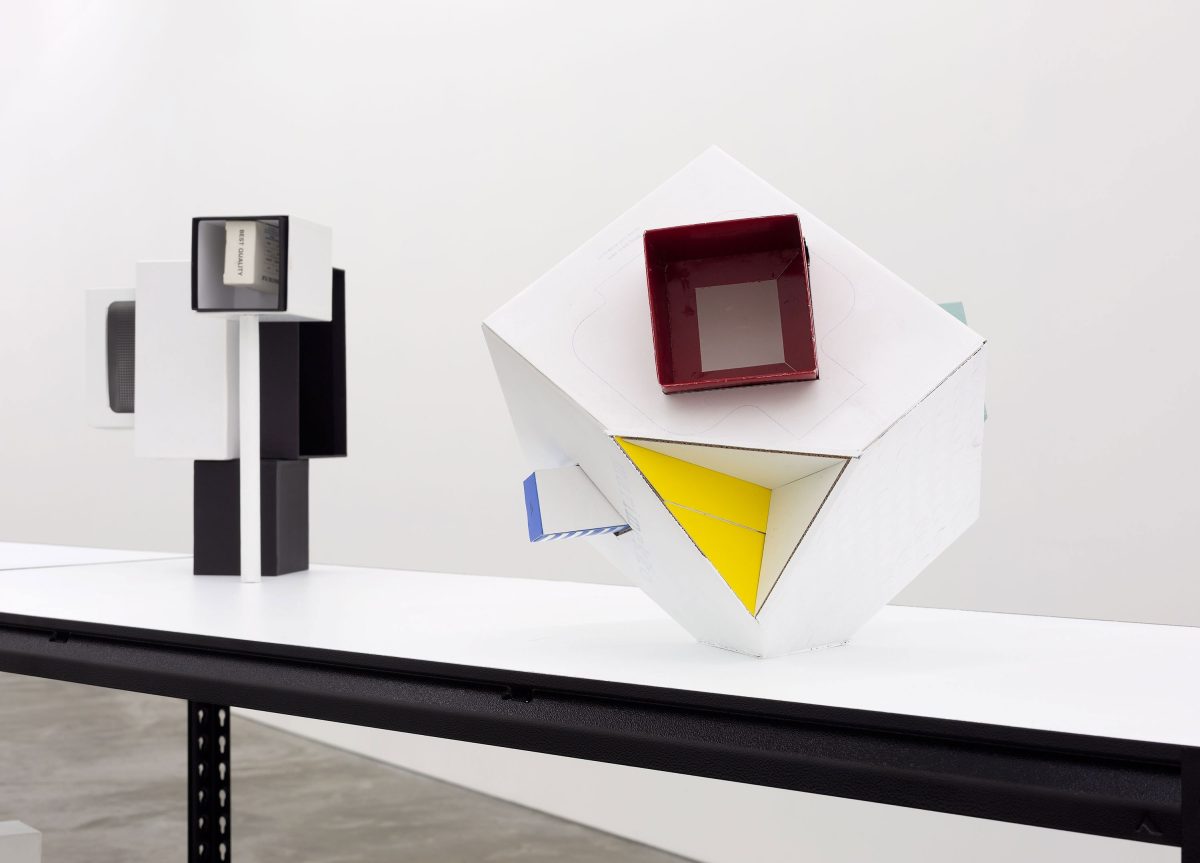
Rose Nolan
Working Models, 2023
Installation View
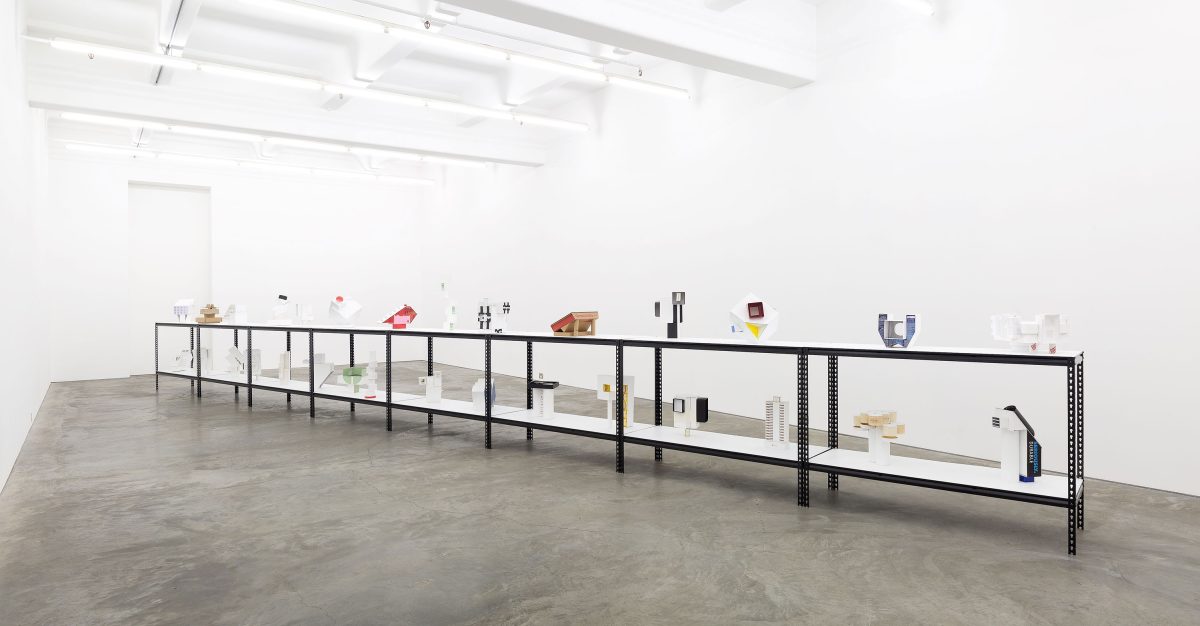
Rose Nolan
‘Working Models’, 2023
Installation view, Anna Schwartz Gallery
Photo: Christian Capurro
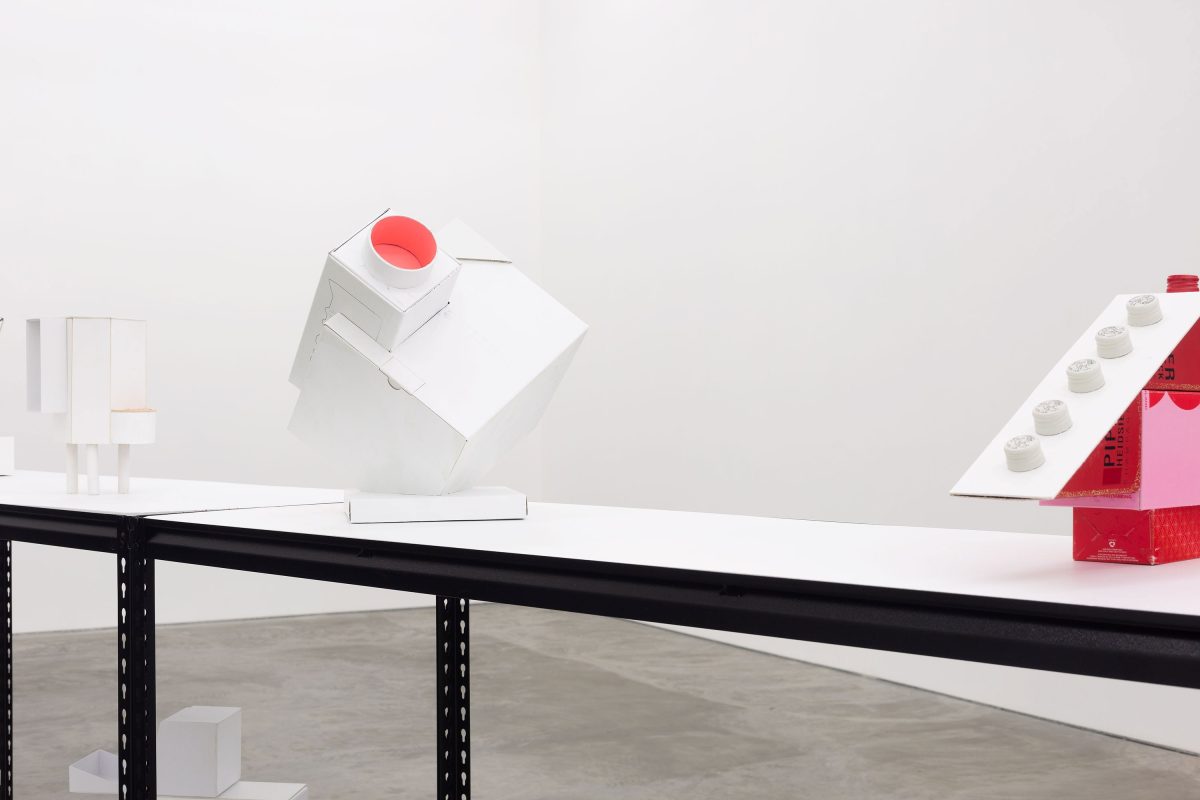
Rose Nolan
Installation View, 2023
Installation View
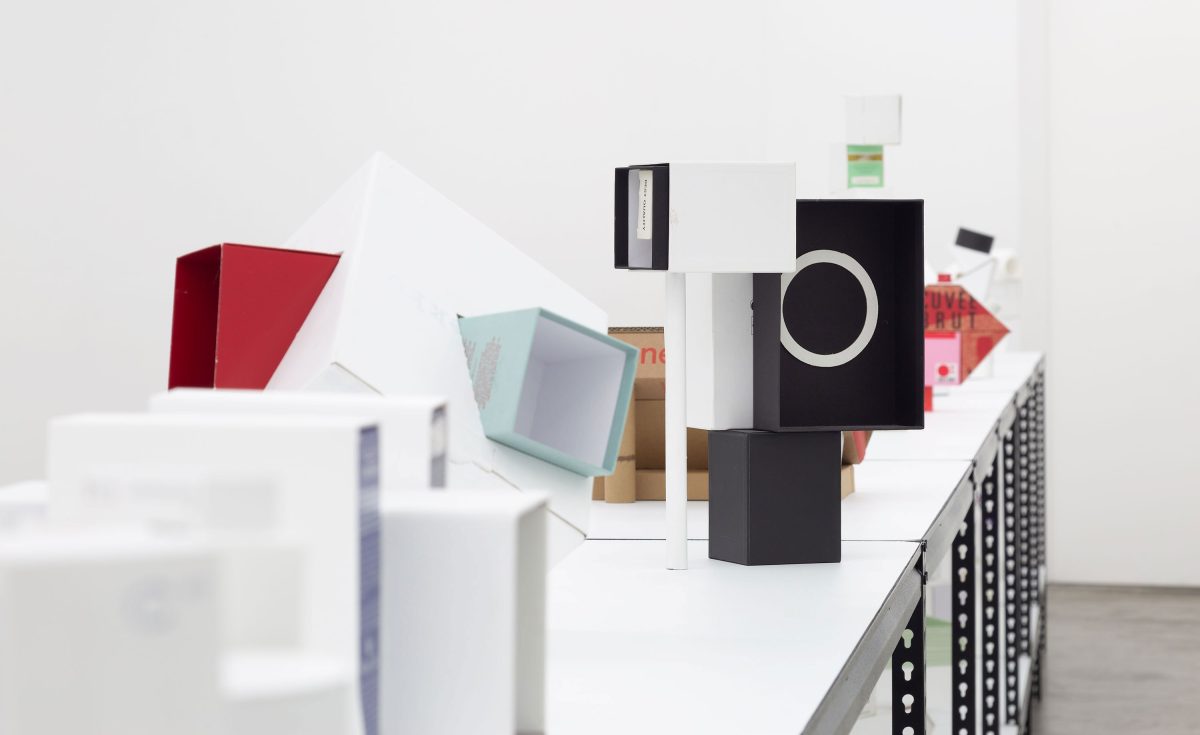
Rose Nolan
‘Working Models’, 2023
Installation view, Anna Schwartz Gallery
Photo: Christian Capurro

Rose Nolan
Installation View, 2023
Installation View
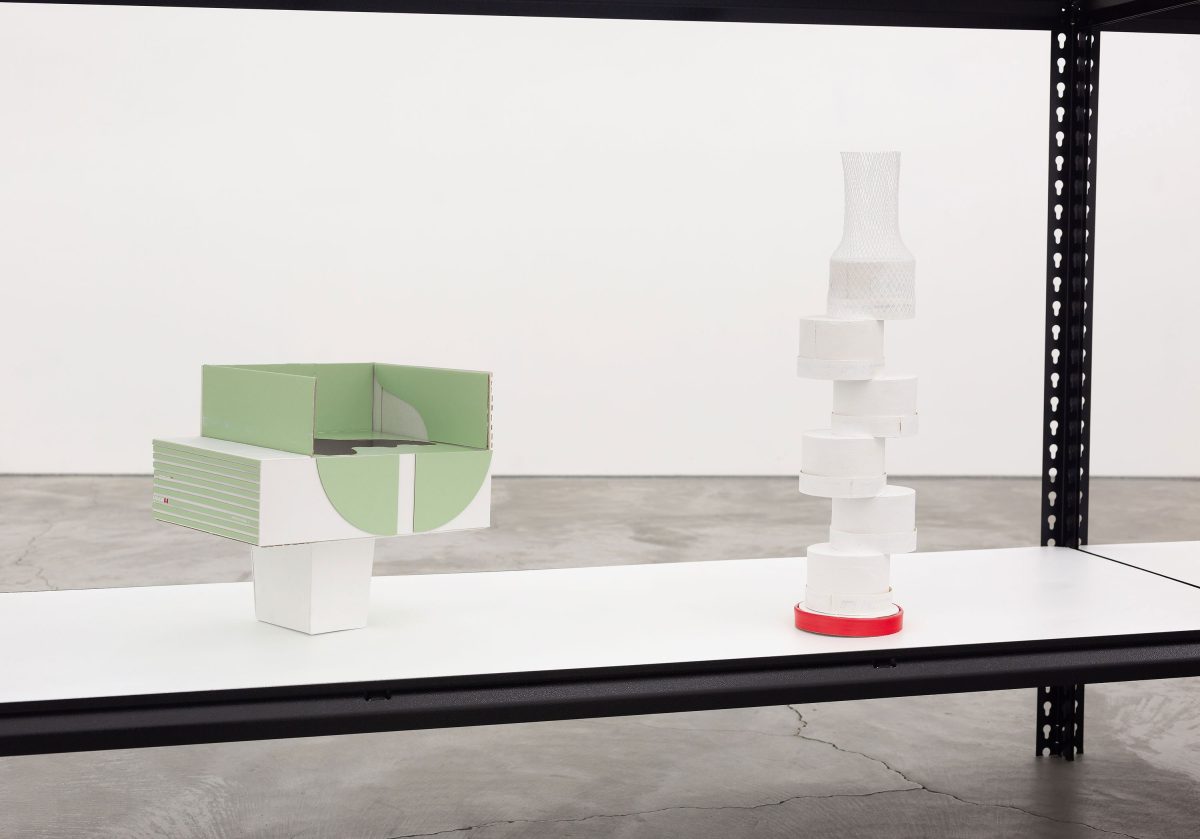
Rose Nolan
Installation View, 2023
Installation View
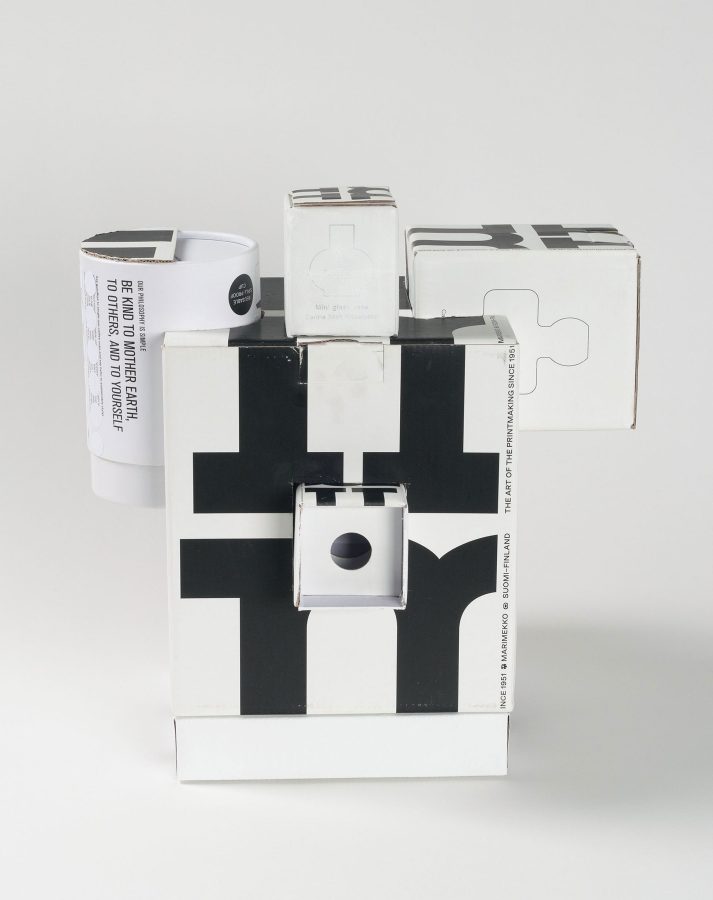
Rose Nolan
Signature Style , 2023
Acrylic paint, cardboard, found packaging
32 x 32 x 32 cm
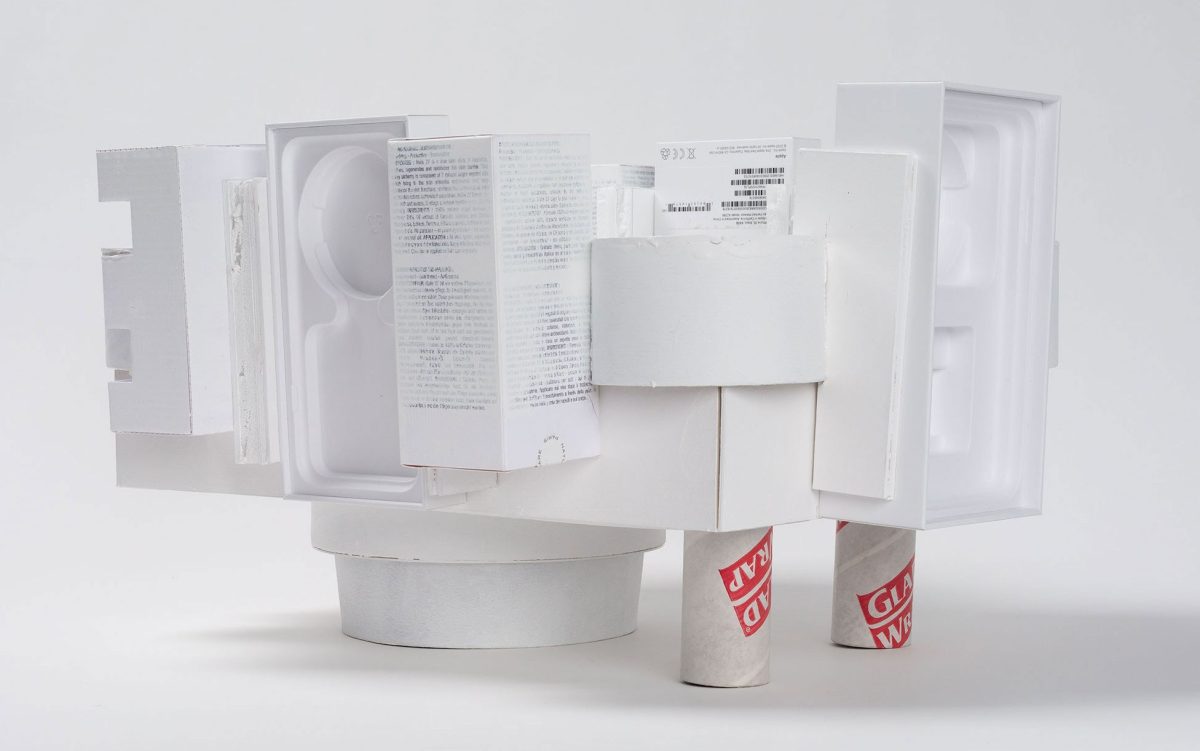
Rose Nolan
Wrapped Temple, 2022
Acrylic paint, found packaging, Glad Wrap rolls
36 x 24 x 21 cm

Rose Nolan
O U Short Stay Motel, 2023
Acrylic paint, cardboard, found packaging
22 x 23 x 24 cm
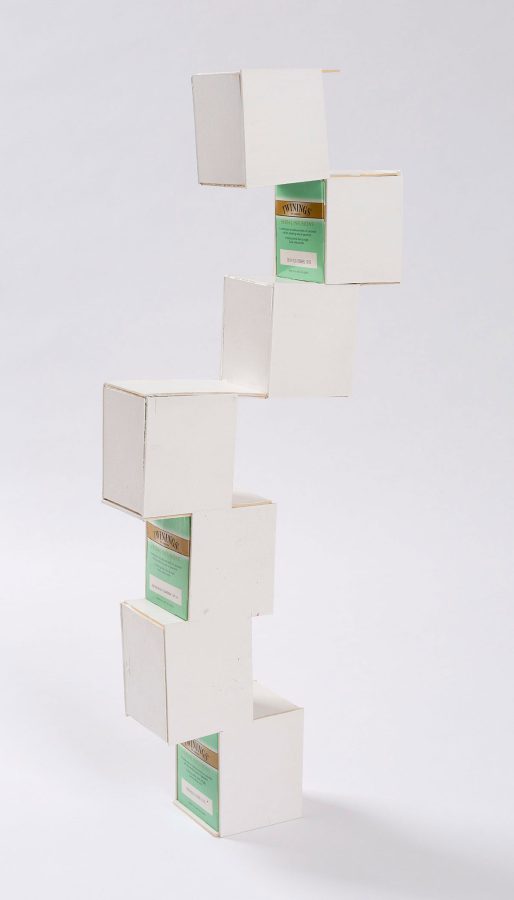
Rose Nolan
Twinings Tea Tower, 2008
found packaging, cardboard, synthetic polymer paint
57 x 23 x 7 cm

Rose Nolan
The FAB/Marimeko House, 2008
found packaging, cardboard, synthetic polymer paint
32.5 x 25 x 21.5 cm
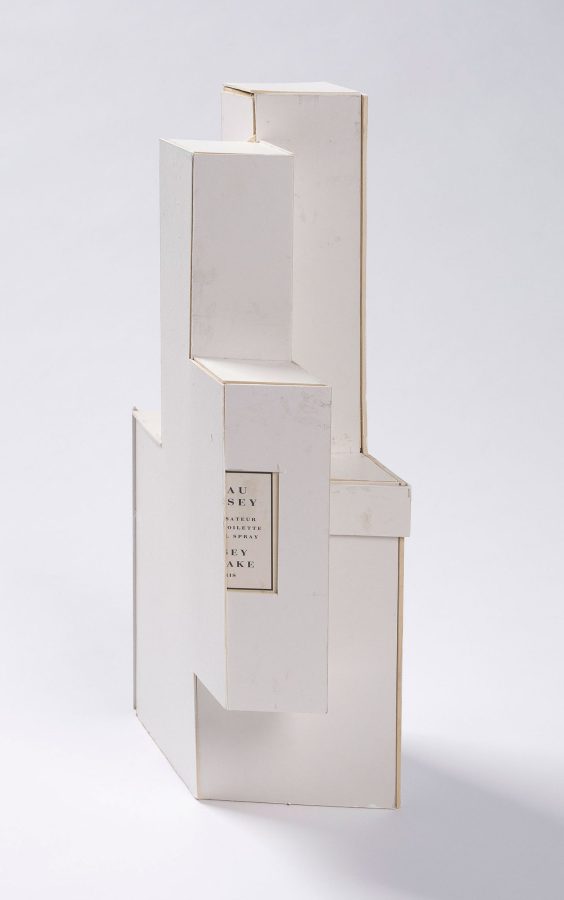
Rose Nolan
The Issey Miyake House, 2008
found packaging, cardboard, synthetic polymer paint
42 x 20 x 12 cm
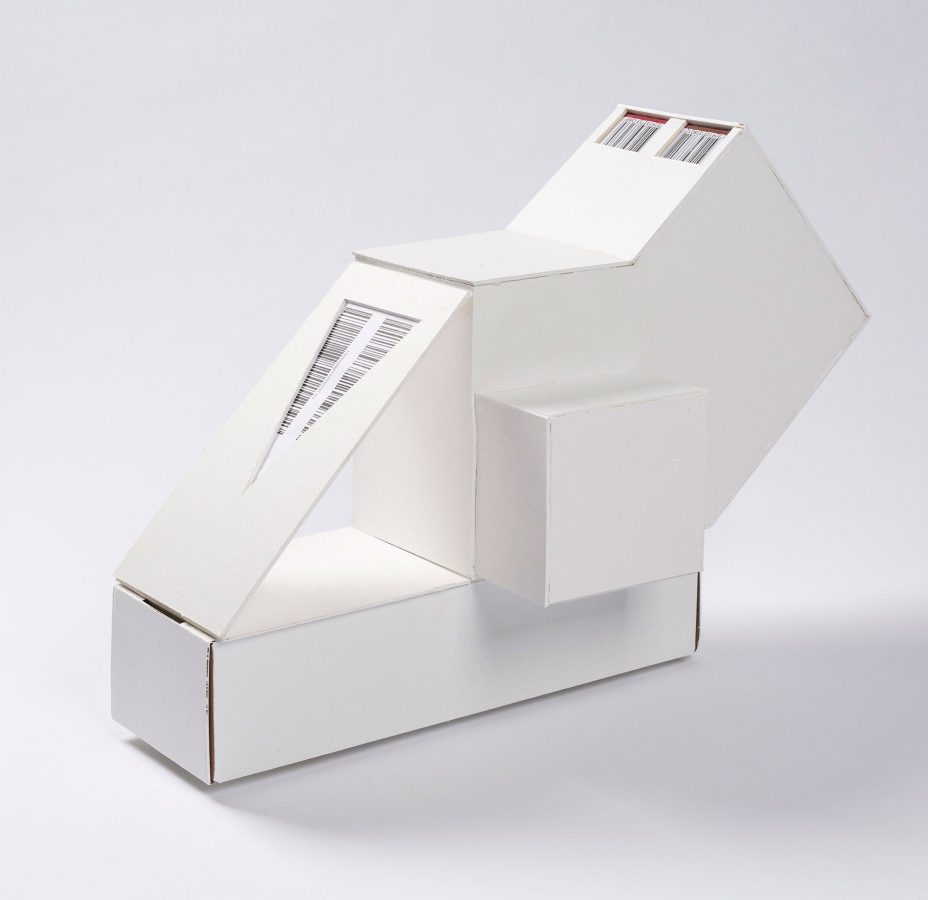
Rose Nolan
Barcode House, 2019
found packaging, cardboard, synthetic polymer paint
30.5 x 44.5 x 25 cm
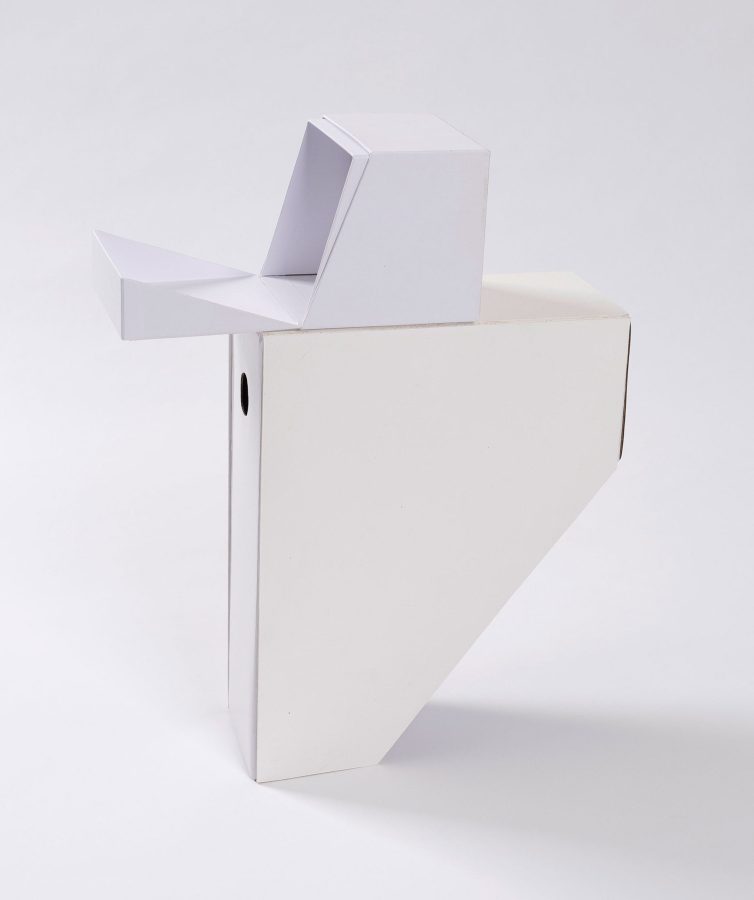
Rose Nolan
Home Office, 2019
found packaging, cardboard, synthetic polymer paint
42 x 34 x 11 cm
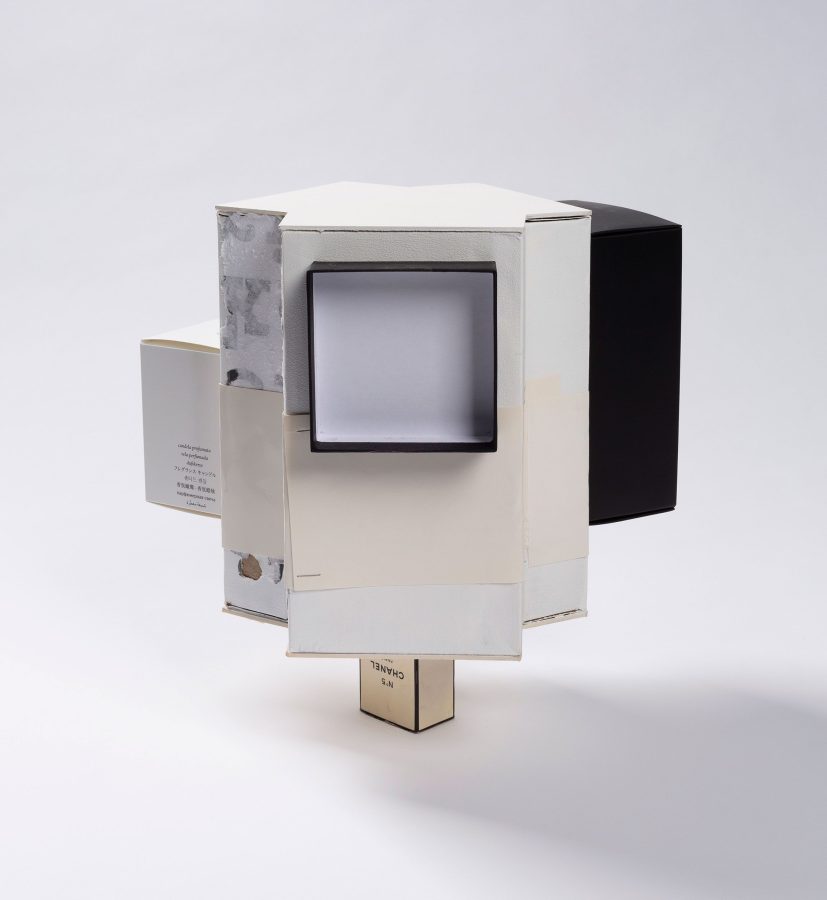
Rose Nolan
Pierre Chareau Studio, 2019
found packaging, cardboard, synthetic polymer paint
31.5 x 29 c 26.5 cm

Rose Nolan
Renzo Piano Store, 2019
found packaging, cardboard, synthetic polymer paint
28 x 19 x 9 cm
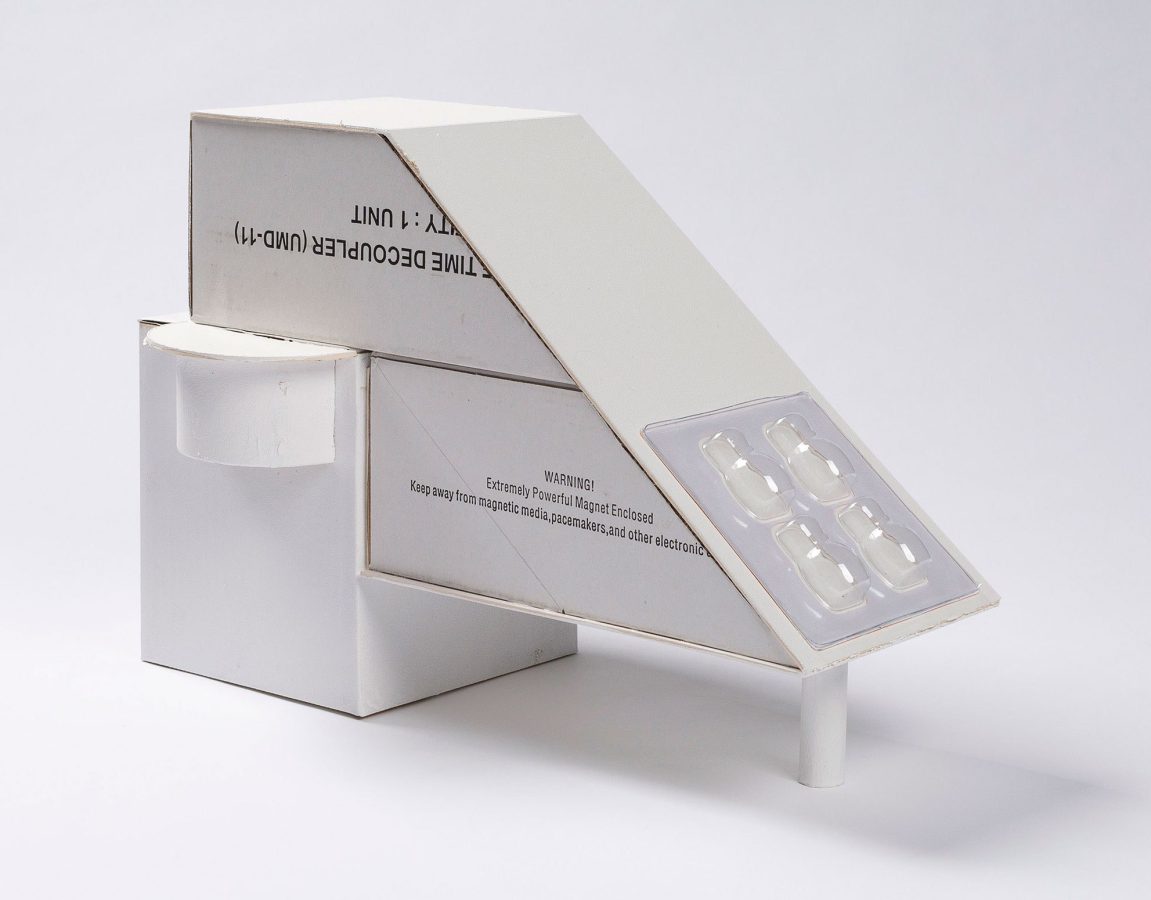
Rose Nolan
Wellness Centre, 2019
found packaging, cardboard, synthetic polymer paint
27.5 x 41 x 23 cm

Rose Nolan
Silo Conversion, 2023
Acrylic paint, found packaging, poster rolls
34 x 32 x 25 cm
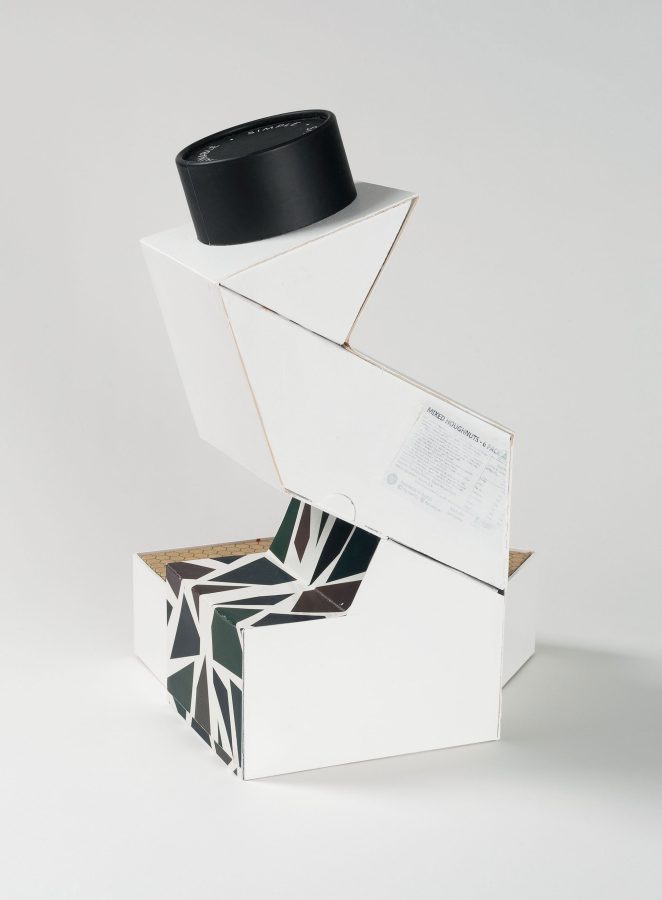
Rose Nolan
Home-Sweet-Home House Museum , 2023
Acrylic paint, cardboard, found packaging, exhibition invitation
39 x 24 x 29 cm

Rose Nolan
Muse Apartments (Premium Mania) , 2023
Acrylic paint, cardboard, found packaging
43.5 x 25.5 x 29 cm
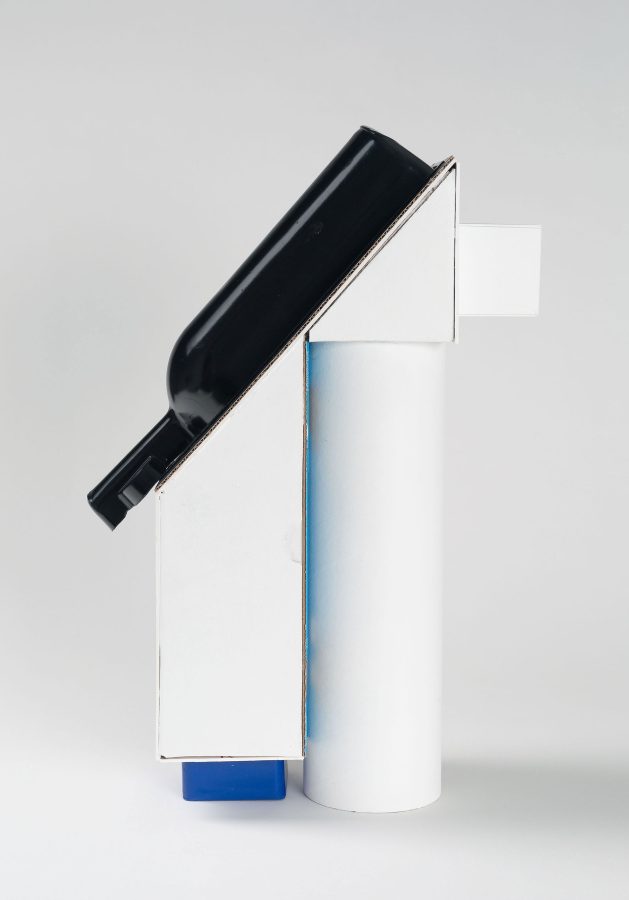
Rose Nolan
New Age / Care Facility , 2023
Acrylic paint, cardboard, found packaging, poster roll
44 x 14 x 31 cm
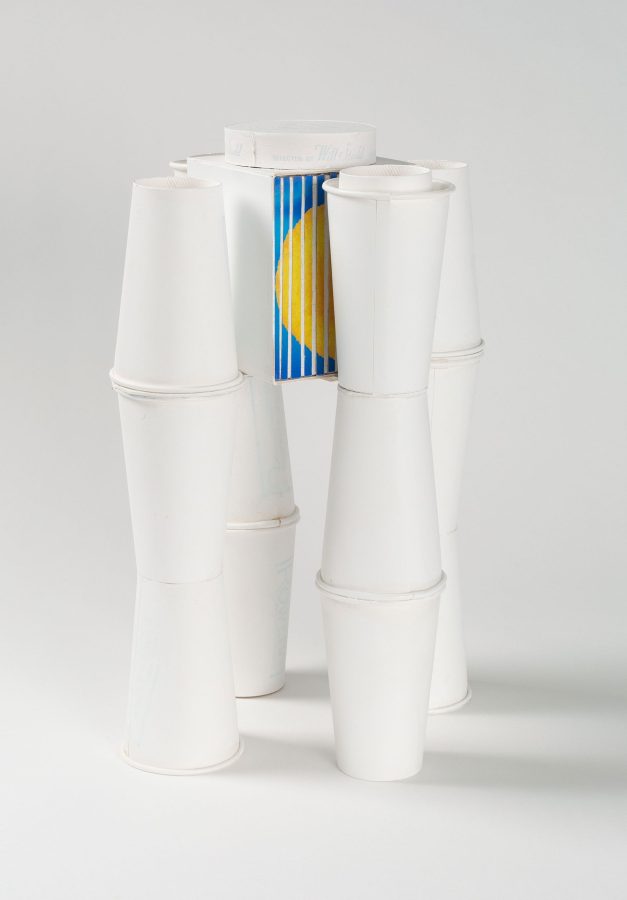
Rose Nolan
LAB , 2022
Acrylic paint, cardboard, found packaging, take-away coffee cups
39 x 28 x 28 cm

Rose Nolan
OSS (One Stop Shop), 2023
Acrylic paint, cardboard, found packaging, cake base, take-away coffee cup
41.5 x 24 x 30 cm
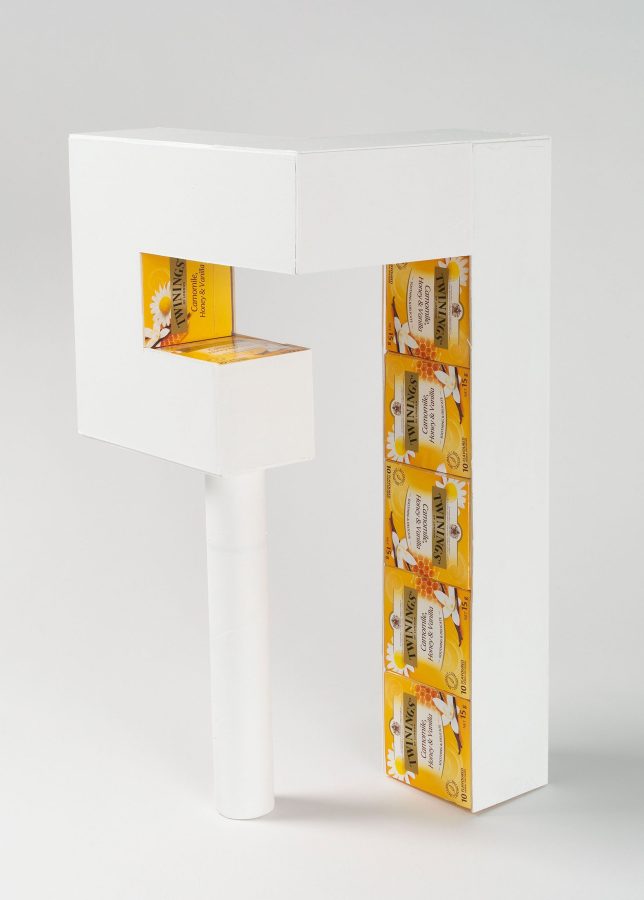
Rose Nolan
T‑Tree House , 2022 – 23
Acrylic paint, cardboard, found packaging, cardboard roll
43 x 21 x 24 cm
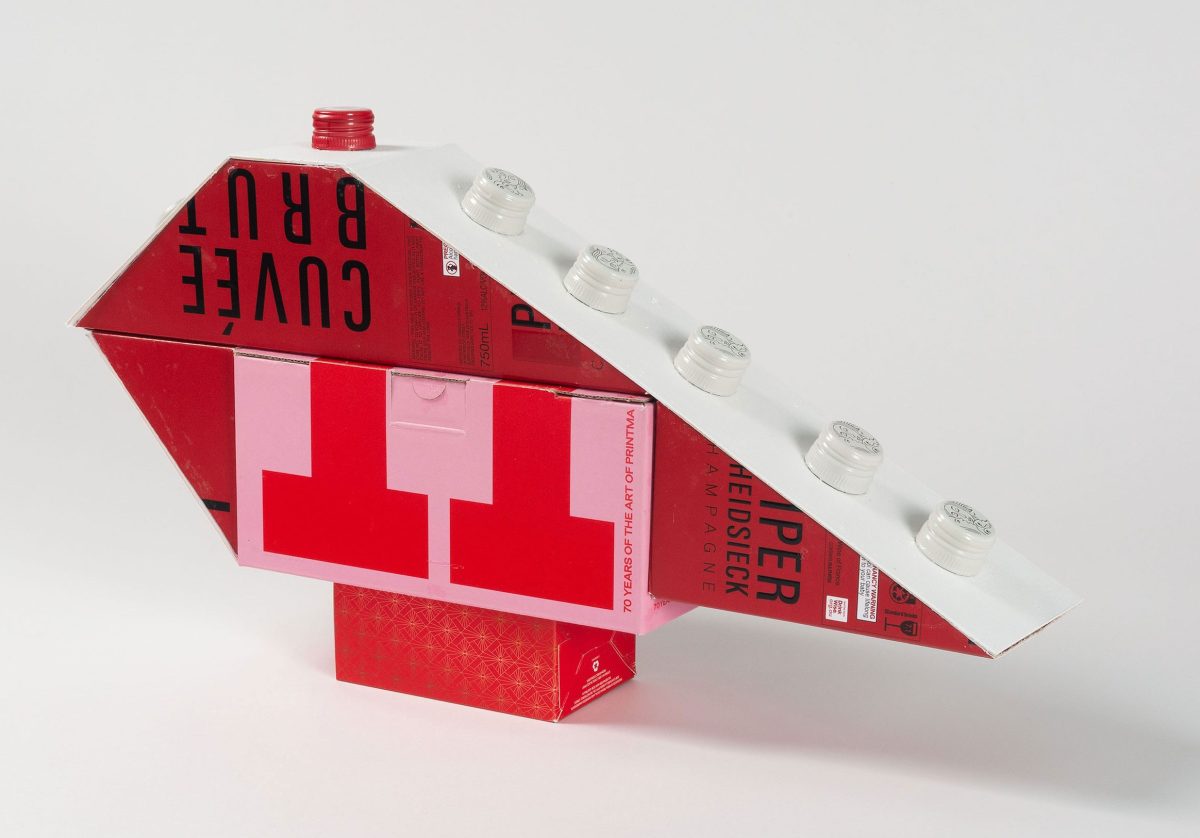
Rose Nolan
CHAPEL, 2023
Acrylic paint, cardboard, found packaging, wine screw tops
26 x 9.5 x 48 cm

Rose Nolan
Mt. Table Top Water Tower , 2023
Acrylic paint, cardboard, found packaging, poster rolls, paper drinking straws
31 x 34 x 34 cm
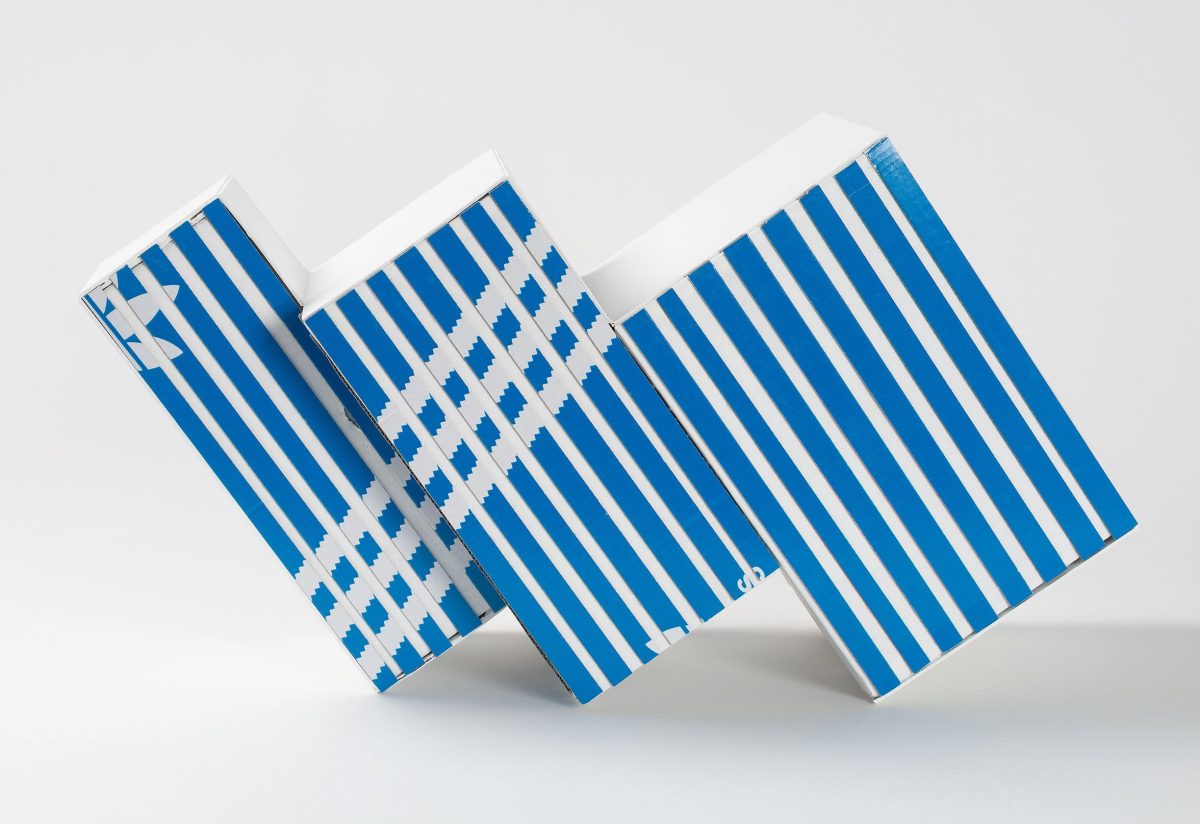
Rose Nolan
FACTORY , 2023
Acrylic paint, cardboard, found packaging
28 x 49 x 15.5 cm
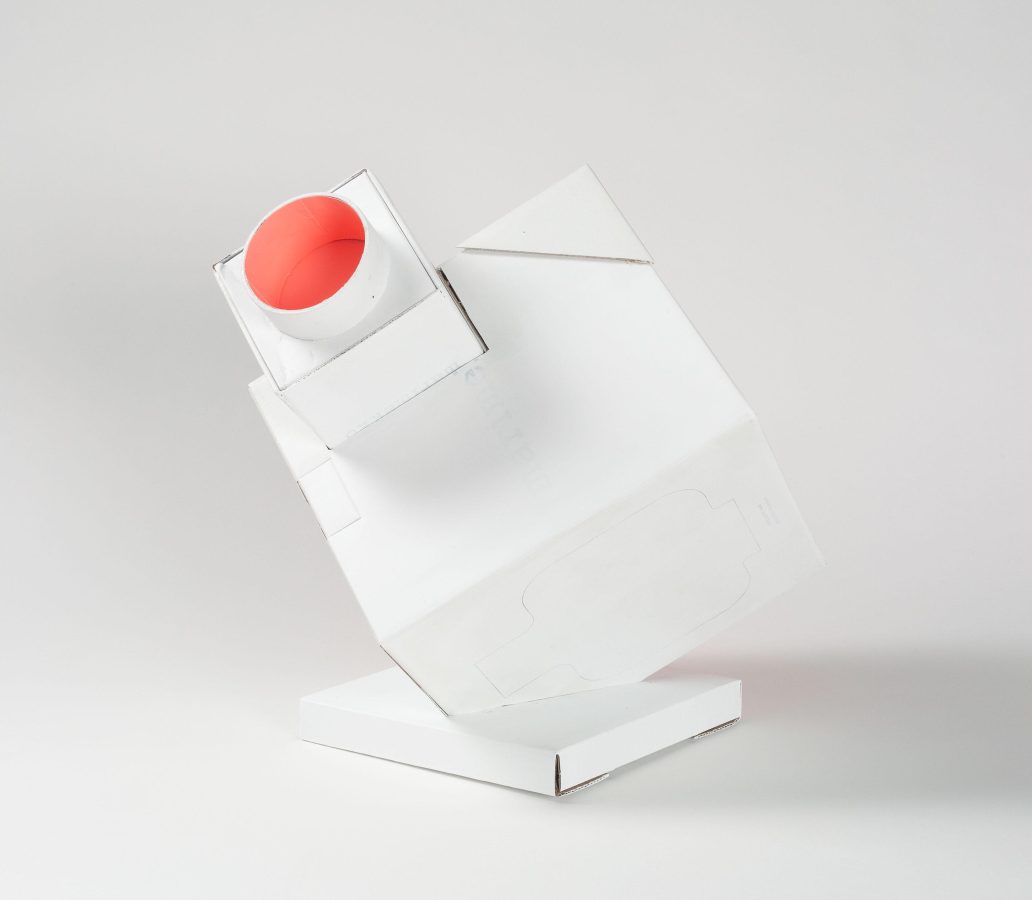
Rose Nolan
James Turrell Fun Palace , 2023
Acrylic paint, cardboard, found packaging
38 x 42 x 38 cm

Rose Nolan
House of the Year , 2023
Acrylic paint, cardboard, found packaging
38 x 40 x 39 cm

Rose Nolan
Adobe House, 2023
Cardboard, found packaging
25 x 28 x 25 cm
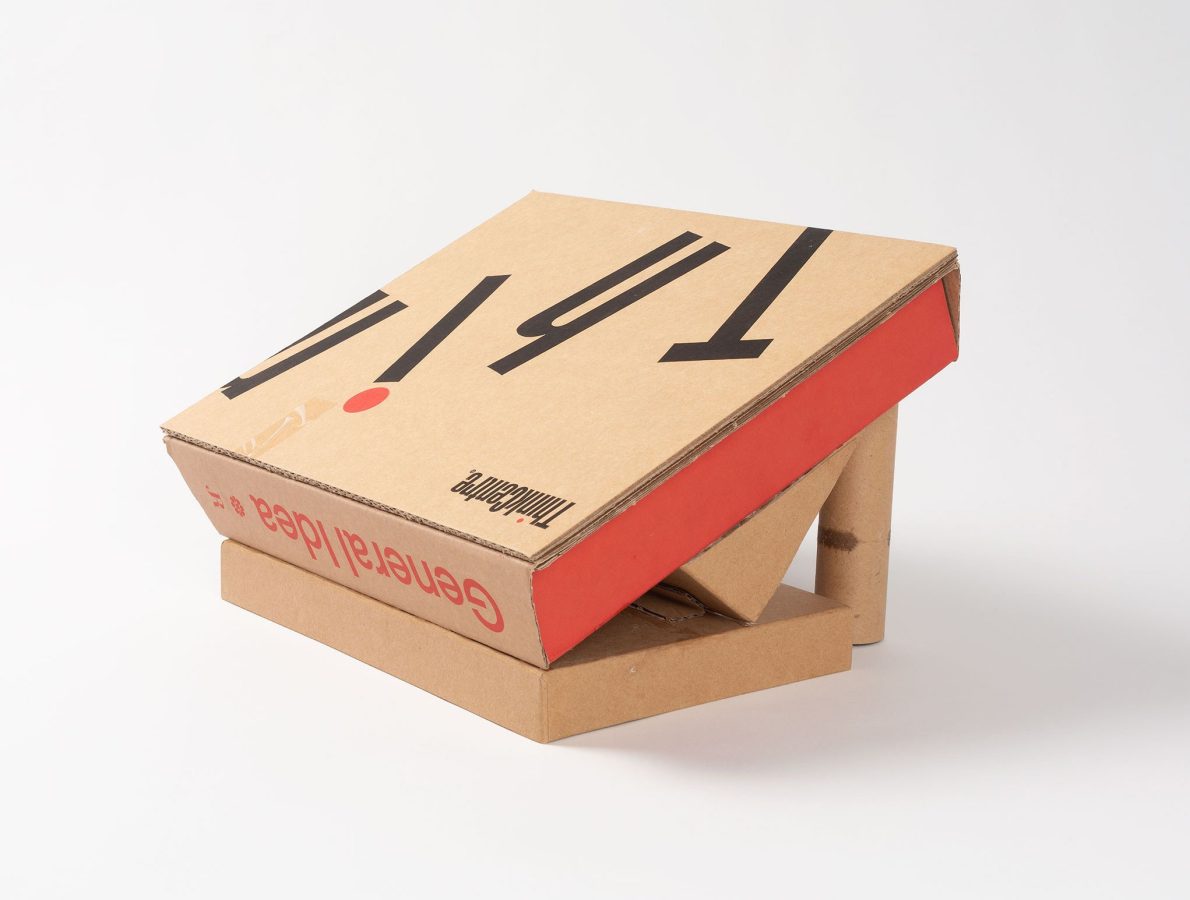
Rose Nolan
Le Corb’s Bath House – cum-Office, 2023
Found packaging, cardboard rolls
20 x 34.5 x 25.5 cm

Rose Nolan
Centrepoint Carpark, 2023
52 x 12.5 x 12 cm
52 x 12.5 x 12 cm
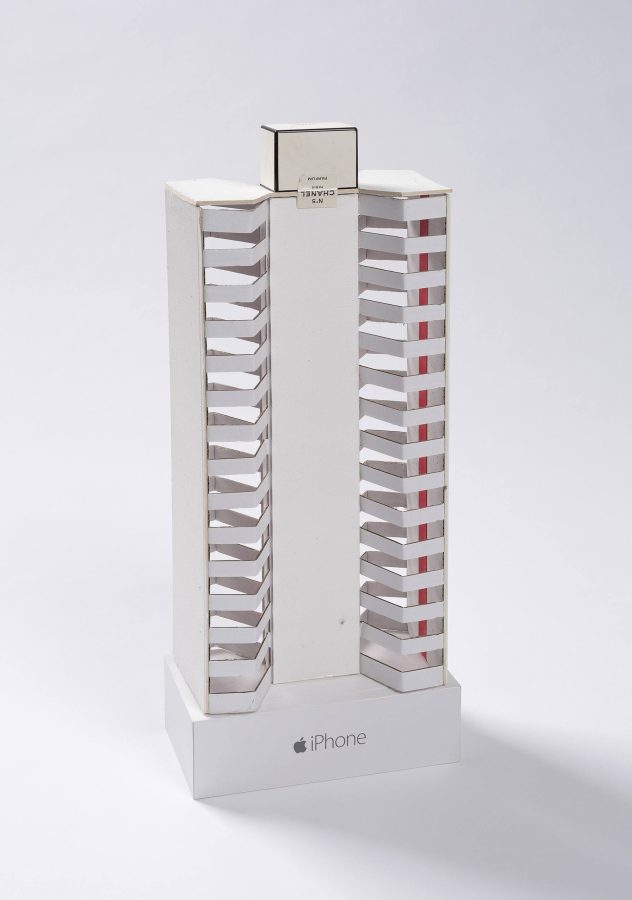
Rose Nolan
iTunes Museum, 2019
found packaging, cardboard, synthetic polymer paint
37 x 15.5 x 8.5 cm
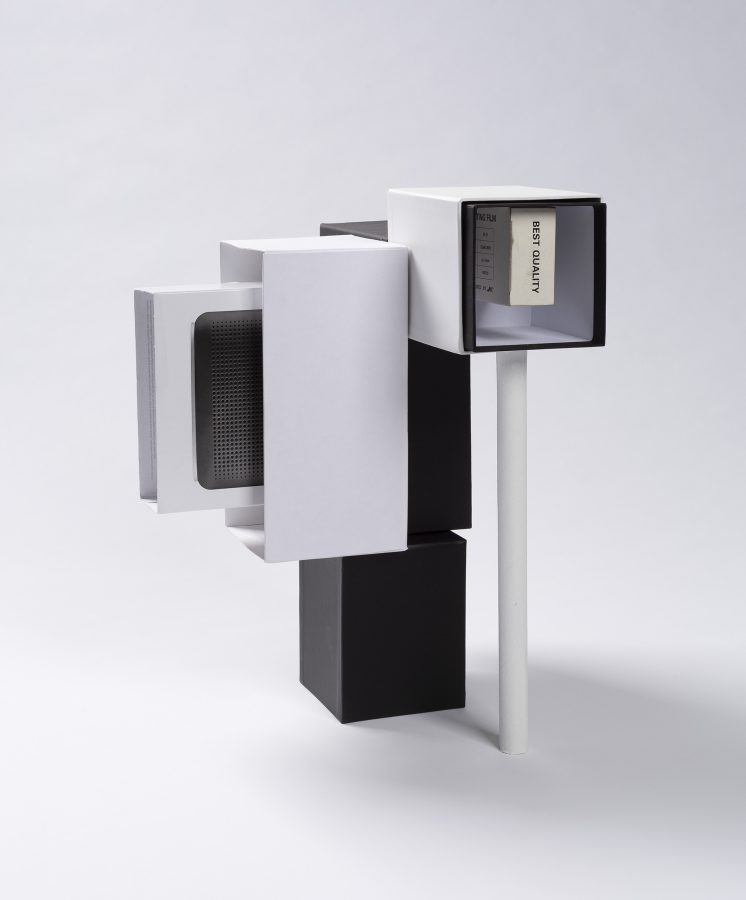
Rose Nolan
NGV Contemporary, 2019
found packaging, cardboard, synthetic polymer paint
37 x 28.5 x 27.5 cm




